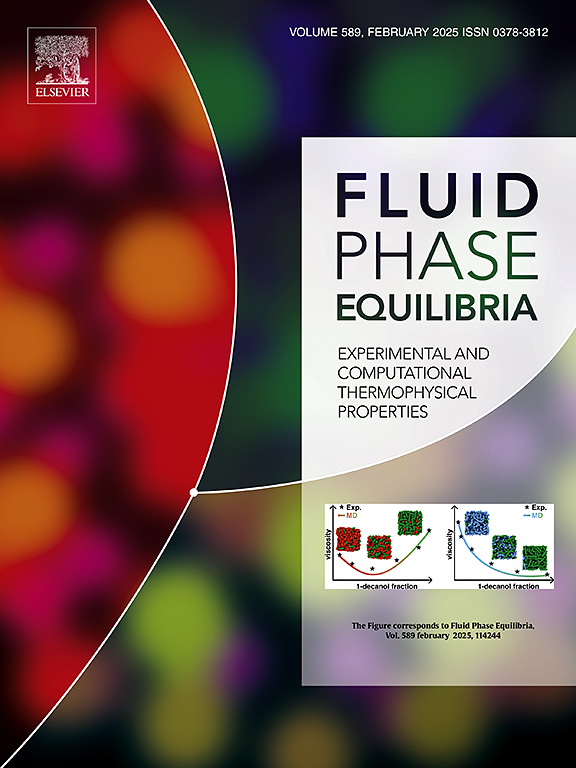ANN-based estimation of pure-component parameters of PC-SAFT equation of state using quantum chemical data
IF 2.7
3区 工程技术
Q3 CHEMISTRY, PHYSICAL
引用次数: 0
Abstract
The perturbed chain-statistical associating fluid theory equation of state (PC-SAFT EoS) is a physical property estimation tool that can be used to calculate a wide range of substance types, temperatures, and pressures. To perform calculations using the PC-SAFT EoS, substance-specific pure-component parameters are required, which are generally determined from liquid density and saturated vapor pressure. Few studies have reported on these parameters, and methods that can obtain pure-component parameters without relying on measured physical properties remain elusive. In this study, an artificial neural network (ANN) is introduced to predict the pure-component parameters of the PC-SAFT EoS. The molecular information estimated from a Gaussian software was used as the input. In addition, we optimized the structure of the ANN by varying the transfer function, number of neurons, and number of hidden layers. The optimized ANN comprises a hard sigmoid transfer function composed of two hidden layers, with 20 and 10 neurons in the first and second layer, respectively. This model can determine the pure-component parameters of the PC-SAFT EoS for a wide range of substance types. Furthermore, SHapley Additive exPlanations analysis on the optimized ANN demonstrates that the contributions of the polarizability and dipole moment are large. However, the feature values related to the shape of the substance are lacking. These results contribute to expanding the range of applications for property estimation using EoS.

基于神经网络的量子化学PC-SAFT状态方程纯组分参数估计
扰动链统计关联流体理论状态方程(PC-SAFT EoS)是一种物理性质估算工具,可用于计算各种物质类型、温度和压力。要使用 PC-SAFT EoS 进行计算,需要特定物质的纯组分参数,这些参数通常根据液体密度和饱和蒸汽压确定。有关这些参数的研究报告寥寥无几,而无需依赖测量物理性质就能获得纯组分参数的方法也仍未出现。本研究引入了人工神经网络(ANN)来预测 PC-SAFT EoS 的纯组分参数。我们使用高斯软件估算的分子信息作为输入。此外,我们还通过改变传递函数、神经元数量和隐层数来优化 ANN 的结构。优化后的 ANN 包含一个由两个隐藏层组成的硬 sigmoid 传递函数,第一层和第二层分别有 20 个和 10 个神经元。该模型可以确定 PC-SAFT EoS 的纯组分参数,适用于多种物质类型。此外,对优化 ANN 进行的 SHapley Additive exPlanations 分析表明,极化率和偶极矩的贡献很大。但是,缺乏与物质形状相关的特征值。这些结果有助于扩大使用 EoS 进行属性估计的应用范围。
本文章由计算机程序翻译,如有差异,请以英文原文为准。
求助全文
约1分钟内获得全文
求助全文
来源期刊

Fluid Phase Equilibria
工程技术-工程:化工
CiteScore
5.30
自引率
15.40%
发文量
223
审稿时长
53 days
期刊介绍:
Fluid Phase Equilibria publishes high-quality papers dealing with experimental, theoretical, and applied research related to equilibrium and transport properties of fluids, solids, and interfaces. Subjects of interest include physical/phase and chemical equilibria; equilibrium and nonequilibrium thermophysical properties; fundamental thermodynamic relations; and stability. The systems central to the journal include pure substances and mixtures of organic and inorganic materials, including polymers, biochemicals, and surfactants with sufficient characterization of composition and purity for the results to be reproduced. Alloys are of interest only when thermodynamic studies are included, purely material studies will not be considered. In all cases, authors are expected to provide physical or chemical interpretations of the results.
Experimental research can include measurements under all conditions of temperature, pressure, and composition, including critical and supercritical. Measurements are to be associated with systems and conditions of fundamental or applied interest, and may not be only a collection of routine data, such as physical property or solubility measurements at limited pressures and temperatures close to ambient, or surfactant studies focussed strictly on micellisation or micelle structure. Papers reporting common data must be accompanied by new physical insights and/or contemporary or new theory or techniques.
 求助内容:
求助内容: 应助结果提醒方式:
应助结果提醒方式:


